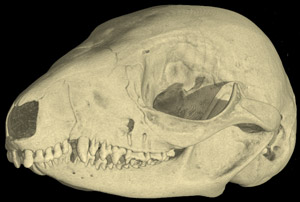El monito del monte (Dromiciops gliroides) is a nocturnal marsupial from South America. The species has a very restricted distribution, occurring only in the forests of the Andean Mountains in south-central Chile and slightly west of the Argentine border. The preferable habitat of el monito del monte is dense, humid forests with thickets of Chilean bamboo. The species is very small, weighing from 16-31 g. Body length ranges from 8-11 cm and the tail is often as long as the body, ranging from 9-13 cm (Nowak, 1991).
El monito del monte is the only extant member of a group of marsupials known as Microbiotheriidae. Since all other members of Microbiotheriidae are extinct, el monito del monte is often called a “living fossil” (Bozinovic, 2004; Lobos et al., in press). Another interesting fact about this species is that it is more closely related to the Australian marsupials than to the South American marsupials with which it is sympatric (Horovitz and Sánchez-Villagra, 2003; Asher et al., 2004; Lobos et al., in press).
The diet of the species is diverse, including fruit (Bozinovic, 2004), insects and other invertebrates (Nowak 1991; Bozinovic, 2004), and the larvae and pupae of invertebrates (Anderson and Jones, 1984). The species hibernates in the winter and lives off fat stored in the tail. Before hibernation begins, individuals will build up their fat storage, a process that can double their weight (Anderson and Jones, 1984; Nowak, 1991)!
The mating season occurs in the spring from October to December. Individuals live in pairs throughout this period. Nests are created from sticks, leaves, grasses, and mosses. Nests can be found in a variety of places including under rocks or fallen trees, inside logs, and in branches. Litter size ranges from one to five young (Nowak, 1991).
Additional Information on the Skull
Click on the thumbnails below for labeled images of the skull in standard anatomical views.

About the Species
This specimen (FMNH 127463) was collected from Valle de La Picada, Osorno, Los Lagos, Chile by P. L. Meserve and B. K. Lang on March 5 1984. It was made available to the University of Texas High-Resolution X-ray CT Facility for scanning by Mr. Ted Macrini of the Department of Geological Sciences, The University of Texas at Austin. Funding for scanning was provided by a National Science Foundation Dissertation Improvement Grant (DEB-0309369) to Mr. Macrini. Funding for image processing was provided by a National Science Foundation Digital Libraries Initiative grant to Dr. Timothy Rowe of The University of Texas at Austin.

About this Specimen
The specimen was scanned by Matthew Colbert on 28 January 2004 along the coronal axis for a total of 711 slices. Each slice is 0.04 mm thick, with an interslice spacing of 0.04 mm and a field of reconstruction of 16.5 mm.

About the
Scan
Literature
Anderson, S., and J. K. Jones Jr. 1984. Order and Families of Recent Mammals of the World. John Wiley & Sons, Inc., New York, NY. pp 686.
Asher, R. J., I. Horovitz, and M. R. Sánchez-Villagra. 2004. First combined cladistic analysis of marsupial mammal interrelationships. Molecular Phylogenetics and Evolution 33: 240-250.
Bozinovic, F., G. Ruiz, and M. Rosenmann. 2004. Energentics and torpor of a South American "living fossil," the microbiotheriid Dromiciops gliroides. Journal of Comparative Physiology B 174: 293-297.
Giannini, N. P., Abdala, F. and D. A. Flores. 2004. Comparative postnatal ontogeny of the skull in Dromiciops gliroides (Marsupialia: Microbiotheriidae). American Museum Novitates 3460:1-17.
Horovitz, I., and M. R. Sánchez-Villagra. 2003. A morphological analysis of marsupial mammal higher-level phylogenetic relationships. Cladistics 19: 181-212.
Lobos, G., Charrier, A., Carrasco, G. and R. E. Palma. in press. Presence of Dromiciops gliroides (Microbiotheria: Microbiotheriidae) in the deciduous forests of central Chile. Mammalian Biology.
Nowak, R. M. 1991. Walker's Mammals of the World. The Johns Hopkins Univeristy Press, Baltimore, MD. pp 642.
Links
Dromiciops gliroides on the Animal Diversity Web (University of Michigan Museum of Zoology)
monito del monte on Wikipedia
the brain of D. gliroides on BrainMuseum.org

Literature
& Links
Front page image.
|
 |

Additional
Imagery

